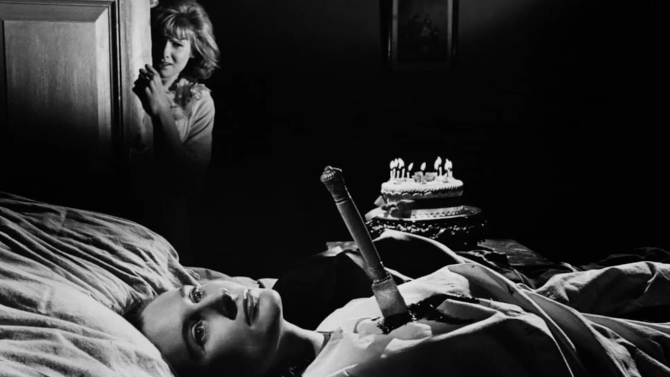
Night Terrors
Unlike most other memorable Hammer horror movies, the 1964 mystery thriller Nightmare, directed by Freddie Francis (perhaps better known as the cinematographer of films like David Lynch’s The Elephant Man and Martin Scorsese’s Cape Fear) eliminates all of the monsters for an old fashioned quasi ghost story... the piece deserving to be remembered up there with those Hammer horror films centered on vampires, resurrected corpses, and lycanthropes. Shot in shadowy black and white, the story follows struggling seventeen year old Janet (Jennie Linden), who is currently away from home living at a finishing school for girls.
-

Night Terrors
NightmareOctober 17, 2024Unlike most other memorable Hammer horror movies, the 1964 mystery thriller Nightmare, directed by Freddie Francis (perhaps better known as the cinematographer of films like David Lynch’s The Elephant Man and Martin Scorsese’s Cape Fear) eliminates all of the monsters for an old fashioned quasi ghost story... the piece deserving to be remembered up there with those Hammer horror films centered on vampires, resurrected corpses, and lycanthropes. Shot in shadowy black and white, the story follows struggling seventeen year old Janet (Jennie Linden), who is currently away from home living at a finishing school for girls.
-

Eternity Box
Creep BoxJanuary 22, 2024An Indie sci-fi film on the precipice of where we might be heading, Creep Box, written and directed by Patrick Biesemans (and based upon his own short from 2022), ruminates on a hybrid artificial intelligence that is both intriguing and terrifying. Following Caul (Geoffrey Cantor), a PHD in psychology and parapsychology at HDTH Corp, he is currently working on a sleek black tech box... a device that can be used to collect the memories of the dead, which are then fused with an A.I. that can utilize the past of the deceased to not only communicate with loved ones, but also gather information that could lead to solving crimes of those who have been murdered.
-

Blind Alley
Nightmare AlleyNovember 28, 2023Guillermo del Toro’s first foray into the realm of film noir, 2021's Nightmare Alley brings all of the Golden Age classic charm of the Studio System along with a classic pulpy story (based off of the novel of the same name by William Lindsay Gresham... as well as the 1947 movie adaptation), which is then fused with his own unique visual style. Following Stanton Carlisle (Bradley Cooper), a drifter, or is it grifter (after all, this is a neo-noir), with a dark past, he aimlessly stumbles upon a traveling carnival... taking a day’s work, he soon after accepts an offer from owner Clem Hoatley (Willem Dafoe) to join the team – seeing it as the perfect way to disappear from his secret history.
-

Candle Wick in the Wind
John Wick: Chapter 4April 9, 2023Covering some new and old ground in the longest feature of the franchise (coming in at a whopping two hours and forty-nine minutes), John Wick: Chapter 4, directed by Chad Stahelski (who has helmed each of the four films), starts us off pretty much right after the previous picture. Flipping the script a bit from the last one, Wick (Keanu Reeves), now healed (boy, does he do that quickly – though it’s supposed to be a couple months later), must deal with the claustrophobic landscape that has enveloped him due to his unsatiated revenge-filled drive. Walking the perilous path of dealing with hitmen, as well as friends and enemies (who can often switch allegiances on a dime), the memorable faces of the underground web weaver – the Bowery King (Laurence Fishburne), New York powerhouse – Winston (Ian McShane), his trusty concierge – Charon (Lance Reddick, who sadly passed away on March 17th), and the head of the table – Elder (George Georgiou), will all make appearances again... though perhaps not in the ways we might expect.
-

Guestwork
The Uninvited GuestOctober 15, 2022Reveling in the motifs of Edgar Allan Poe, think madness/insanity, a haunting location, the double, the uncanny, and maybe even death, Guillem Morales (Julia’s Eyes) explores the recesses of the mind in his directorial debut (he also writes the screenplay), The Uninvited Guest (2004). Who knew a four-thousand square foot home could be so claustrophobic. Félix (Andoni Gracia) finds himself alone in the weeks following the break-up from his longtime wife, Vera (Mónica López). With her having moved into a tiny three-hundred and fifty square foot apartment, it baffles Félix’s mind... unable to comprehend how anyone could downsize so drastically.
-

Unblushing Brides
The Brides of DraculaOctober 2, 2022Sometimes, a movie title can be misleading. Imagine heading to the theatre in 1960, excited to see Terence Fisher’s Hammer horror film The Brides of Dracula, only for the opening voice-over to exclaim, just a couple of seconds in, that Dracula is dead – that might be a bit of a letdown. But don’t worry, a new vampire will rise to start his own harem. I know what you must be thinking... did he immigrate to Europe from Utah? No, he’s one of those unusual, ultra kinky Europeans, but more on that later.
